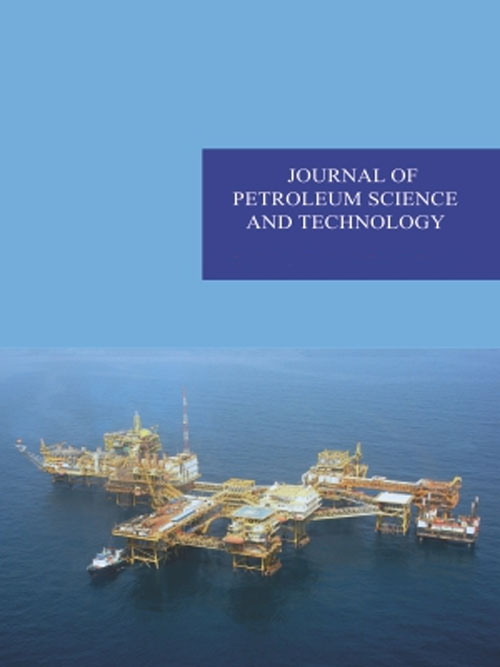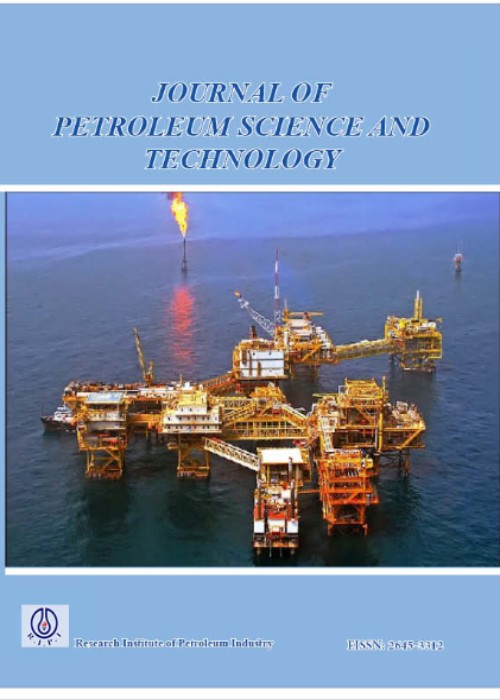فهرست مطالب

Journal of Petroleum Science and Technology
Volume:7 Issue: 1, Winter 2017
- تاریخ انتشار: 1395/12/20
- تعداد عناوین: 8
-
-
Page 3According to the temperature distribution of water injection well-bore in highly deviated wells under different conditions and unstable temperature field heat conduction principles, a true three-dimensional model was established to analyze the law of variation on temperature of highly deviated wells during the water injection process, and to analyze the factors that influence the water injection well-bore in highly deviated wells; this can improve the computational accuracy of the transformation of water injection string made by the temperature, and help us predicate the transformation of water injection string more accurately during the production process. The results show that the temperature distribution of highly deviated wells are greatly affected by water injection inlet temperature or injection of water inlet temperature, water injection rate, and water injection time. With the temperature field model of highly deviated wells made in this paper, the construction quality and oil production can be highly improved by reasonably controlling the temperature. All the findings which have been obtained form a theoretical basis and the experimental research for the development of mechanical analysis simulation software have been used to calculate temperature distribution and variation of water injection string in highly-deviated wells and have a great theoretical significance and practical value.Keywords: Highly Deviated Well, Water Injection, Temperature Profile, Numerical Calculation, Experimental Research
-
Page 13An oil and gas well cementing in Gachsaran formation, where sustained annular pressure has been reported in many wells, presents a big challenge in Maroon field. The main challenges are preventing gas migration and achieving zonal isolation using a competent cement sealant system which is able to withstand downhole stresses and high temperatures during production cycles. Unlike conventional cement systems, properties, such as, high Poissons ratio and low Youngs modulus compared to that of the rock were optimized in the new system to achieve mechanical resistance and durability. The use of elastic-expandable additives to solve problems in oil well cementing has been investigated in recent years by several research groups in the petroleum industry. This study includes the laboratory examination of the effect of an elastic-expandable additive on the physical properties of a new cement sealant system. In the research process, a candidate well was selected and the properties of the used cement slurry in a problematic section of the well were evaluated in the laboratory. Then, the elastic-expandable additive was added as an elastic agent and the improvements in the cement slurry and stone properties were studied. This article discusses the problems associated with the conventional cement used in the candidate well and gives the detail of the improvements in cement properties obtained by adding the elastic-expandable additive to the cement slurry formulation as an elastic agent. The elastic-expandable additive increases the Poissons ratio and expansion set cement, but it decreases the Youngs modulus and fluid loss of the cement slurry. In addition, to prevent gas migration and achieve zonal isolation, there is an optimum concentration of the elastic-expandable additive at which the maximum compressive strength is reached. The results of this study can be used to optimize the cement slurry design in any given set of conditions.Keywords: Expandable Additive, Compressive Strength, Rheological Properties, Young's Modulus, Poisson's Ratio
-
Page 23Cellulose was modified by polystyrene (PS) and polyacrylonitrile (PAN) via free radical and living radical polymerization, and then cellulose was used as the matrix in the preparation of polymer/clay nanocomposite, through a solution intercalation method. For this purpose, first, the graft polymerization of styrene (St) onto cellulose fibers was performed by using suspension polymerization and the free-radical polymerization technique in the presence of potassium persulfate (PPS). Second, the synthesized cellulose-graft-polystyrene was brominated by N-bromosuccinimide (NBS) to obtain polymers with bromine a group. Third, the brominated cellulose fibers were used as macroinitiators in the atom transfer radical polymerization (ATRP) of acrylonitrile (AN) in the presence of CuCl / 2, 2-bipyridine (Bpy) catalyst system in THF solvent at 90˚C to prepare the cellulose-graft-polystyrenegraftpolyacrylonitrile. Forth, for preparing the modified clay, Na-MMT was mixed with hexadecyl trimethyl ammonium chloride salt. Finally, cellulose-graft-polystyrenegraftpolyacrylonitrile/organoclay bionanocomposite was prepared in CCl4 by a solution intercalation method. Then, the structure of the obtained terpolymer was investigated by FT-IR, DSC, TGA, XRD, and SEM techniques. Moreover, the structure of the bionanocomposite was probed by XRD, SEM, and TEM images.Keywords: Bionanocomposite, Cellulose, Styrene, Atom Transfer Radical Polymerization, Modified Clay
-
Page 35Knowledge of the orientation of horizontal in situ stresses is important to some areas of oil and gas field development plans. Borehole breakouts observed in image logs and drilling-induced fractures are the main parameters for the determination of the stresses directions in situ.
In this work, the orientations of borehole breakouts were investigated as a function of depth in oil wells A and B in Lali oilfield, in the Southwest of Iran. Borehole breakouts were detected from FMI logs. By the statistical analysis of the borehole breakouts orientation in the foregoing two wells, it was found that, while a mean orientation of minimum horizontal stress in well A is NE-SW, the azimuth of breakout in well B is different with a mean azimuth of 312˚±10˚. The result reveals that the orientation must be different in these two wells due to some geological abnormality. Therefore, accurate and reliable geomechanical analyses are crucial steps toward minimizing the costs of drilling and completion programs and mitigating borehole instability problems.Keywords: In Situ Stresses, Borehole Breakout, Drilling, induced Fractures, Lali Oilfield -
Page 42Barium sulfate (barite) is one of the widely used weighting materials in the preparation of drilling fluid for deep oil and gas wells. Barite is not soluble in the regular solvents; such as, hydrochloric acid (HCl) and other acids. Therefore, in this study, we focused on evaluating the dissolution of the industrial barite particles in different chelating agents. Chelating agents; such as, diethylene triamine penta acetic (DTPA), ethylene diamine tetra acetic (EDTA), and hydroxyethyl ethylene diamine tri acetic (HEDTA) acids with high and low pH values were used in this study. The effect of the base of chelating agents, namely alkali and alkali earth hydroxides, on the dissolution of barite was also investigated. For the first time, the optimum pH, concentration, and base (sodium or potassium) of chelating agents which yielded the maximum dissolution were investigated in this study at a high temperature. Previous studies did not consider the wellbore constraints during their experiments and they used chelating agent volume to barite weight ratio, which could not be implemented in the real wells. In this study and for the first time, we considered the wellbore volume (chelating agent volume that can be used) and the barite weight (filter cake) during the dissolution experiments. Based on the results obtained from this study, potassium base DTPA-K5 and EDTA-K4 of a concentration of 20 wt.% were found to be the most effective chelating agents to dissolve barite. The solubility of barite was found to be 26.8 g/L in a solution containing 20 wt.% of DTPA-K5 and 25.6 g/L in a solution containing 20 wt.% of EDTA-K4 during a soaking time of 24 hrs and a pH value above 11 at 200°F.Keywords: Barium Sulfate (Barite) Solubility, Barite Solubility, Chelating Agents, DTPA, EDTA
-
Page 57For the characteristics of horizontal fractures in shallow low-permeability oil layers after hydraulic fracturing in multilayer reservoirs, horizontal fractures are taken equivalent to an elliptical cylinder with the reservoir thickness using the equivalent permeability model; then, upon the elliptic seepage theory, the seepage field which has led by a vertical well with horizontal fractures is divided into two parts: (1)radial flow from the external formation to the equivalent area of horizontal fracture and (2) elliptic flow in the equivalent area of horizontal fracture. The loss of pressure caused by threshold pressure gradient, material balance in the reservoir, and multi-well pressure superposition principle are synthesized to calculate the performance. Finally, separate-layer multi-stage horizontal fractured well performance is deduced by summing the performance of high-permeability oil layers and fractured thin low-permeability oil layers. Low-permeability thin oil layers in Xing Shu-Gang oilfield are taken as practical cases, and the well space limits and economic reservoir thickness limits are calculated by the performance model; the relationship among recovery and productivity intensity, and the ratio of thin low-permeability oil layers thickness to the total thickness are also discussed.Keywords: Multilayer Reservoir, Low, permeability Thin Oil Layer, Horizontal Fracture, Five, spot Waterflood Pattern, Performance
-
Page 67This paper presents the effect of high viscosity oil and two-phase foamy-oil flow on the performance of a single stage centrifugal pump. As a part of this, the applicability of a pipe viscometer to determine the foamy oil viscosity is investigated. Unlike previous studies, a sealed fluid tank is used in a closed flow loop to allow conditioning the two-phase mixture to create foamy-oil. Furthermore, the sealed tank enables the accurate determination of the gas void fraction (GVF) of the foamy-oil under steady state conditions. The results show that up to a GVF of 38%, the foamy-oil improves head performance in comparison with the single-phase pump performance. In addition, the viscosity of foamy oil is found to be similar to the single-phase oil due to the Newtonian behavior of foamy oil. New correction factors have been developed to predict the performance of a single-stage centrifugal pump handling foamy oil.Keywords: centrifugal pump performance, two, phase foamy, oil, electrical submersible pump performance, foamy, oil viscosity
-
Page 79The rheological properties of four different Kuwaiti crude oils in the presence of polyacrylamide (PAA) were investigated. PAA was varied at three different concentrations of 25, 50, and 75 ppm to study the viscoelastic properties in the untreated samples. Four different temperatures (25, 30, 35, and 40 °C) were used to evaluate different viscoelastic parameters of the treated and untreated Kuwaiti crude oils. The sulfur content and physical properties; such as, density and refractive index of Kuwaiti crude oils were also measured.
An important observation noted from the rheological analysis is that the dynamic viscoelastic parameters like complex modulus, elastic modulus, and storage modulus were found to be a function of the amount of sulfur present in the crude oil. The most important observation noted is that PAA acts as a drag reducing agent in lowering the viscosity, shear stress, and all the viscoelastic parameters of the Kuwaiti crude oil. Carreau model was used in this investigation to determine the relaxation time and the shear thinning characteristics of the treated and untreated crude oil samples at different temperatures.Keywords: Crude oil, Rheology, Polyacrylamide, Elemental Analysis, Complex Modulus, Storage Modulus


